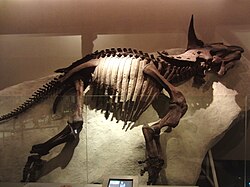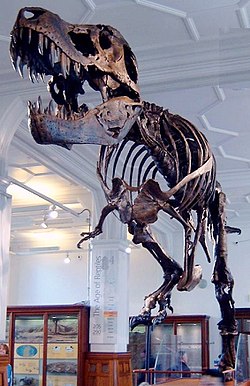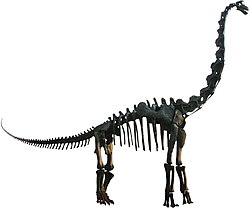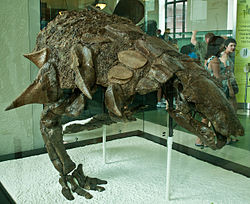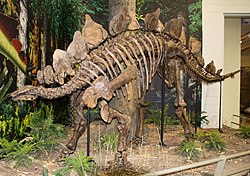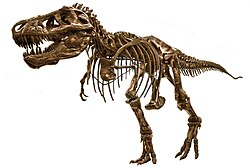Type of Exhibit Taxon Catalogue number Nickname Exhibiting Institution City State Country Notes Image Skeleton, mounted Acrocanthosaurus atokensis NCSM 14345 Fran North Carolina Museum of Natural Sciences Raleigh North Carolina USA Skeleton, mounted (copy) Acrocanthosaurus atokensis NCSM 14345 (copy) Houston Museum of Natural Science Houston Texas USA Skull Albertosaurus sarcophagus TMP 1985 098 0001 Royal Tyrrell Museum Drumheller Alberta Canada Skeleton, mounted Allosaurus fragilis AMNH 5753 American Museum of Natural History New York New York USA Skeleton, mounted Allosaurus fragilis CM 11844 Carnegie Museum of Natural History Pittsburgh Pennsylvania USA Skeleton, mounted Allosaurus fragilis DMNS 2249 Denver Museum of Nature and Science Denver Colorado USA Skeleton, mounted Allosaurus fragilis LACM 46030 Natural History Museum of Los Angeles County Los Angeles California USA Skeleton, mounted (copy) Allosaurus jimmadseni MOR 693 (copy) Big Al (copy) Museum of the Rockies Bozeman Montana USA Skeleton, mounted (copy) Allosaurus jimmadseni SMA 0005 (copy) Big Al 2 (copy) Houston Museum of Natural Science Houston Texas USA Skeleton, mounted Anchiceratops NMC 8547 (body), NMC 8535 (copy of skull) Canadian Museum of Nature Ottawa Ontario Might represent a separate taxon Partial skull Anchiceratops ornatus FMNH P15003 Field Museum of Natural History Chicago Illinois USA Partial skull Anchiceratops ornatus ROM 802 Royal Ontario Museum Toronto Ontario Canada Skull Anchiceratops ornatus TMP 1983.001.0001 Royal Tyrrell Museum Drumheller Alberta Canada Skeleton, mounted Apatosaurus AMNH 460 American Museum of Natural History New York New York USA Skeleton, mounted Apatosaurus louisae CM 3018 Carnegie Museum of Natural History Pittsburgh Pennsylvania USA Skeleton, mounted Apatosaurus FMNH P25112/FMNH P27021 Field Museum of Natural History Chicago Illinois USA May represent a novel species within Apatosaurus Skeleton, mounted (copy) Barosaurus lentus AMNH 6341 (copy) American Museum of Natural History New York New York USA Skeletal elements, unmounted Brachiosaurus altithorax FMNH P 25107 Field Museum of Natural History Chicago Illinois USA Holotype specimen Skeleton, mounted (copy) Brachiosaurus altithorax FMNH P 25107 (copy) Field Museum of Natural History Chicago Illinois USA Cast of the holotype specimen Skeleton, mounted (copy) Brachiosaurus altithorax FMNH P 25107 (copy) O'Hare International Airport Chicago Illinois USA Cast of the holotype specimen Skeleton, mounted Brontosaurus excelsus YPM 1980 Peabody Museum of Natural History New Haven Connecticut USA Holotype specimen Skeleton, panel mounted Camarasaurus lentus CM 11338 Carnegie Museum of Natural History Pittsburgh Pennsylvania USA Skeleton, mounted Camptosaurus aphanoecetes CM 11337 Carnegie Museum of Natural History Pittsburgh Pennsylvania USA Skull Centrosaurus apertus AMNH 5427 American Museum of Natural History New York New York USA Skull Centrosaurus apertus ROM 767 Royal Ontario Museum Toronto Ontario Canada Skeleton, mounted Chasmosaurus belli ROM 843 Royal Ontario Museum Toronto Ontario Canada Skeleton, mounted Corythosaurus casuarius CM 5856 Carnegie Museum of Natural History Pittsburgh Pennsylvania USA Skull Cryolophosaurus ellioti FMNH PR1821 (copy) Field Museum of Natural History Chicago Illinois USA Real skull in collections Skeleton, mounted (copy) Cryolophosaurus ellioti FMNH PR1821 (copy) Fryxell Geology Museum Rock Island Illinois USA Skeleton, mounted (copy) Cryolophosaurus ellioti FMNH PR1821 (copy) Orton Geological Museum Columbus Ohio USA Skull Daspletosaurus horneri MOR 590 Museum of the Rockies Bozeman Montana USA Holotype specimen Skeleton, mounted Daspletosaurus torosus CMN 8506 Canadian Museum of Nature Ottawa Ontario Canada Holotype specimen Skeleton, mounted Daspletosaurus FMNH PR308 Gorgeous George Field Museum of Natural History Chicago Illinois USA Originally assigned to Gorgosaurus Skeleton, mounted Diplodocus carnegiei CM 84 Dippy Carnegie Museum of Natural History Pittsburgh Pennsylvania USA Holotype specimen Skeleton, mounted Diplodocus longus DMNH 1494 Denver Museum of Nature and Science Denver Colorado USA Skeleton, mounted Dracorex hogwartsia TCMI 2004.17.1 The Children's Museum of Indianapolis Indianapolis Indiana USA Skeleton, mounted Dryosaurus elderae CM 3392 Carnegie Museum of Natural History Pittsburgh Pennsylvania USA Model Dryptosaurus aquilunguis Bess Bower Dunn Museum Libertyville , Illinois USA Skeleton, mounted Edmontonia rugosidens AMNH 5665 American Museum of Natural History New York New York USA Skeleton, mounted Edmontosaurus annectens AMNH 5730 and AMNH 5886 American Museum of Natural History New York New York USA Fossil mummy Edmontosaurus annectens AMNH 5060 Trachodon mummy American Museum of Natural History New York New York USA Skull Edmontosaurus annectens LACM 23502 Natural History Museum of Los Angeles County Los Angeles California USA Skeleton Edmontosaurus annectens YPM 2182 Peabody Museum of Natural History New Haven Connecticut USA Skeleton Gorgosaurus libratus AMNH 5458 American Museum of Natural History New York New York USA Skeleton Gorgosaurus libratus USNM 12814 National Museum of Natural History Washington D.C. USA formerly AMNH 5428 Skeleton Gorgosaurus libratus TMP 91.36.500 Royal Tyrrell Museum of Palaeontology Drumheller Alberta Canada Sub-adult specimen Skeleton Gorgosaurus sternbergi AMNH 5664 American Museum of Natural History New York New York USA now recognized as a juvenile Gorgosaurus libratus Skull Lambeosaurus lambei AMNH 5353 American Museum of Natural History New York New York USA Skeleton Lambeosaurus lambei FMNH PR 380 (body) UC 1479 (head)
Field Museum of Natural History Chicago Illinois USA Skeleton Lambeosaurus AMNH 5340 American Museum of Natural History New York New York USA Juvenile lambeosaurine hadrosaur originally referred to Procheneosaurus praeceps Skull (copy) Majungasaurus crenatissimus FMNH PR2100 Field Museum of Natural History Chicago Illinois USA Skeleton, mounted Miasaura peeblesorum FMNH PR2538 Field Museum of Natural History Chicago Illinois USA Skull Mojoceratops AMNH 5401 American Museum of Natural History New York New York USA previously referred to Chasmosaurus kaiseni Skull Pachycephalosaurus wyomingensis AMNH 1696 American Museum of Natural History New York New York USA Skeleton, mounted Pachyrhinosaurus TMP 2002.76.1 Royal Tyrell Museum Drumheller Alberta Canada Skeleton, mounted Parasaurolophus cyrtocristatus FMNH P27393 Field Museum of Natural History Chicago Illinois USA Holotype specimen Skeleton, mounted (copy) Patagotitan mayorum MPEF -PV 3400 (copy) American Museum of Natural History New York New York USA
Composite of six specimens Skeleton, mounted (copy) Patagotitan mayorum MPEF -PV 3400 (copy) Maximo Field Museum of Natural History Chicago Illinois USA Composite of six specimens Skeleton, mounted Protoceratops andrewsi CM 9185 Carnegie Museum of Natural History Pittsburgh Pennsylvania USA Skeleton, mounted Protoceratops andrewsi FMNH PR 14064 Field Museum of Natural History Chicago Illinois USA Skull Regaliceratops TMP 2005.055.0002 Royal Tyrrell Museum Drumheller Alberta Canada Skeleton, mounted Rapetosaurus krausei FMNH PR 2209 Field Museum of Natural History Chicago Illinois USA Juvenile specimen Skeleton, panel mounted Saurolophus osborni AMNH 5220 American Museum of Natural History New York New York USA Skeleton, mounted Stegosaurus armatus CM 11341 Carnegie Museum of Natural History Pittsburgh Pennsylvania USA Skeleton, mounted Stegosaurus stenops AMNH 650 American Museum of Natural History New York New York USA Skeleton, mounted (copy) Stegosaurus stenops AMNH 650 (copy) Field Museum of Natural History Chicago Illinois USA Skeleton, mounted Stegosaurus stenops DMNS 1483 Denver Museum of Nature and Science Denver Colorado USA Skeleton, mounted Stegosaurus stenops LACM 16440 Natural History Museum of Los Angeles County Los Angeles California USA Skeleton, mounted (copy) Stegosaurus stenops NHMUK PV R36730 (copy) Houston Museum of Natural Science Houston Texas USA Skeleton, mounted Styracosaurus AMNH 5372 American Museum of Natural History New York New York USA Skeleton, mounted Triceratops HMNS 2006.1743.00 Lane Houston Museum of Natural Science Houston Texas USA Skeleton, mounted Triceratops MOR 3027 Yoshi's Trike Museum of the Rockies Bozeman Montana USA Skeleton, mounted Triceratops horridus AMNH 5116 American Museum of Natural History New York New York USA
Skeleton, mounted (copy) Triceratops horridus AMNH 5116 (copy) Cleveland Museum of Natural History Cleveland Ohio USA Skeleton, mounted (copy)
Triceratops horridus AMNH 5116 (copy) Field Museum of Natural History Chicago Illinois USA Skeleton, mounted Triceratops horridus BMRP 2006.4.1 Homer Burpee Museum of Natural History Rockford Illinois USA Sub-adult specimen Skull Triceratops horridus FMNH P12003 Field Museum of Natural History Chicago Illinois USA Skeleton, mounted Triceratops prorsus CM 1219 Carnegie Museum of Natural History Pittsburgh Pennsylvania USA Skeleton, mounted Triceratops prorsus LACM 151459 Natural History Museum of Los Angeles County Los Angeles California USA Skeleton, mounted Tyrannosaurus AMNH 5027 American Museum of Natural History New York New York USA Skeleton, mounted (copy) Tyrannosaurus AMNH 5027 (copy) Denver Museum of Nature and Science Denver Colorado USA Skeleton, mounted (copy) Tyrannosaurus AMNH 5027 (copy) Academy of Natural Sciences of Drexel University Philadelphia Pennsylvania USA Skeleton, mounted Tyrannosaurus BHI 3033 Stan Black Hills Museum of Natural History Hill City South Dakota USA Found in 1987. [ 5] Skeleton, mounted (copy) Tyrannosaurus BHI 3033 (copy) Stan (copy) Dinosaur Discovery Museum Kenosha Wisconsin USA Skeleton, mounted (copy) Tyrannosaurus BHI 3033 (copy) Stan (copy) Houston Museum of Natural Science Houston Texas USA Skull (copy) Tyrannosaurus BHI 3033 (copy) Stan (copy) Jurica-Suchy Nature Museum Lisle Illinois USA Skeleton, mounted (copy) Tyrannosaurus BHI 3033 (copy) Stan (copy) National Museum of Natural History Washington, D.C. District of Columbia USA Skeleton, mounted (copy) Tyrannosaurus BHI 3033 (copy) Stan (copy) New Mexico Museum of Natural History and Science Albuquerque New Mexico USA Skeleton, mounted (copy) Tyrannosaurus BHI 3033 (copy) Stan (copy) Sternberg Museum of Natural History Fort Hays Kansas USA Skeleton, mounted (copy) Tyrannosaurus BHI 3033 (copy) Stan (copy) The Children's Museum of Indianapolis Indianapolis Indiana USA Skeleton, mounted (copy) Tyrannosaurus BHI 3033 (copy) Stan (copy) Weis Earth Science Museum Menasha Wisconsin USA Skeleton, mounted (copy) Tyrannosaurus BHI 3033 (copy) Stan (copy) Wyoming Dinosaur Center Thermopolis Wyoming USA Skeleton, mounted Tyrannosaurus BMR P2002.4.1 Jane Burpee Museum of Natural History Rockford Illinois USA Juvenile specimen Skeleton, mounted (copy) Tyrannosaurus BMR P2002.4.1 (copy) Jane (copy) Carnegie Museum of Natural History Pittsburgh Pennsylvania USA Skeleton, mounted (copy) Tyrannosaurus BMR P2002.4.1 (copy) Jane (copy) Cleveland Museum of Natural History Cleveland Ohio USA Skeleton, mounted Tyrannosaurus rex CM 9380 Carnegie Museum of Natural History Pittsburgh Pennsylvania USA Holotype specimen Skeleton, mounted Tyrannosaurus FMNH PR2081 Sue Field Museum of Natural History Chicago Illinois USA Found in 1990. Most complete. Largest T.rex fossil specimen. Approx. 40 feet long, estimated 9.5 tons (live). [ 5] Skeleton, mounted (copy) Tyrannosaurus FMNH PR2081 (copy) Sue (copy) Disney's Animal Kingdom Bay Lake Florida USA Skeleton, mounted Tyrannosaurus HMNS 2006.1743.01 Wyrex Houston Museum of Natural Science Houston Texas USA Skeleton, mounted Tyrannosaurus LACM 150167 Thomas Natural History Museum of Los Angeles County Los Angeles California USA Skeleton, mounted Tyrannosaurus LACM 23844 Natural History Museum of Los Angeles County Los Angeles California USA Skeleton, mounted Tyrannosaurus LACM 23845 Natural History Museum of Los Angeles County Los Angeles California USA Skeleton, mounted Tyrannosaurus LACM 28471 Natural History Museum of Los Angeles County Los Angeles California USA Juvenile specimen Skeleton, mounted Tyrannosaurus MOR 555 Wankel Rex National Museum of Natural History Washington, D.C. District of Columbia USA On lease from U.S. Army Corps of Engineers [ 6] Skeleton, mounted (copy) Tyrannosaurus MOR 555 (copy) Big Mike Museum of the Rockies Bozeman Montana USA Big Mike is a bronze cast of MOR 555 Skeleton, mounted (copy) Tyrannosaurus MOR 555 (copy) University of California Museum of Paleontology Berkeley California USA Skeleton, mounted (copy) Tyrannosaurus MOR 555 (copy) Cleveland Museum of Natural History Cleveland Ohio USA Skeleton, mounted (copy) Tyrannosaurus MOR 555 (copy) Googleplex Mountain View California USA Skeleton, mounted (copy) Tyrannosaurus MOR 555 (copy) Perot Museum of Nature and Science Dallas Texas USA Skeleton, mounted Tyrannosaurus MOR 980 Peck's Rex Museum of the Rockies Bozeman Montana USA Skeleton, mounted (copy) Tyrannosaurus MOR 980 (copy) Peck's Rex (copy) Carnegie Museum of Natural History Pittsburgh Pennsylvania USA Skeleton, mounted (copy) Tyrannosaurus MOR 980 (copy) Peck's Rex (copy) Maryland Science Center Baltimore Maryland USA Skeleton, mounted Tyrannosaurus RTMP 81.6.1 Black Beauty Royal Tyrrell Museum Drumheller Alberta Canada Skeleton, mounted Tyrannosaurus RTMP 81.12.1 Huxley T.rex Royal Tyrrell Museum Drumheller Alberta Canada Skeleton, mounted Tyrannosaurus TCM 2001.90.1 Bucky The Children's Museum of Indianapolis Indianapolis Indiana USA Skeleton, mounted (copy) Tyrannosaurus TCM 2001.90.1 (copy) Bucky (copy) Houston Museum of Natural Science Houston Texas USA Skeleton, mounted (copy) Zuniceratops christopheri MSM P 4185 (copy) Arizona Museum of Natural History Mesa Arizona USA Skull (copy) Zuniceratops christopheri MSM P 4185 (copy) Natural History Museum of Utah Salt Lake City Utah USA 